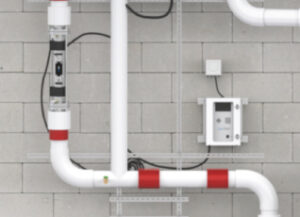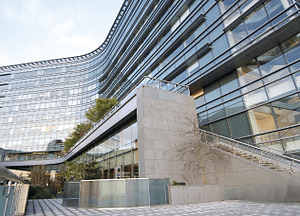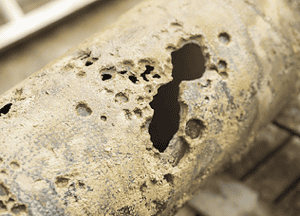Water from municipal water systems is often contaminated with small amounts of bacteria, parasites, fungi, and other organisms that escaped disinfection methods. The low amounts of these organisms generally do not cause disease but can pose a threat in complex or multi-story plumbing systems due to various factors.
Common causes of waterborne pathogens
Waterborne pathogens in building water systems can be caused by a variety of sources, including:
- Water temperature fluctuations
- Biofilm
- Water stagnation
- Sediment
- Changes in water pressure
- Low levels of disinfectants
- Construction
- Water main breaks
- Municipal water supply
Common types of waterborne pathogens
There are many different types of waterborne pathogens living in building plumbing systems. The most common include:
- Legionella
- Pseudomonas
- Acinetobacter
- Mycobacteria
- Burkholderia
- Stenotrophomonas
- Cryptosporidium
- Giardia
Legionella
Legionella, the bacteria that causes Legionnaires’ disease, occurs naturally in freshwater. The low amounts of Legionella in freshwater systems generally do not lead to disease. However, Legionella can pose a health risk if it gets into building water systems. Once there, Legionella will grow and spread throughout the plumbing, heating, cooling, and other water-using systems. Eventually, it will be released into the environment through tiny water droplets that people can breathe in, potentially causing Legionnaires’ disease. Once one person contracts it, it has the potential to spread to others, causing an outbreak.
Pseudomonas
Pseudomonas is a type of bacteria found in soil, water, and other moist environments. It has been identified as a cause of many illnesses in humans, animals and plants. Some species of Pseudomonas are beneficial to agriculture as plant pathogens or as symbionts of legumes, while some can cause serious infections in hospitals and is associated with many diseases, including pneumonia, urinary tract infections, sepsis, and blood infections. It is commonly spread through direct contact with contaminated water, like hand washing or showering, but it can also be contracted from drinking water dispensers, swimming pool equipment, and water filters. The bacteria are capable of producing toxins or antibiotics that can kill other bacteria and produce pigments such as pyoverdin or pyocyanin. Treatment for Pseudomonas infections usually includes antibiotics such as ciprofloxacin or gentamicin applied topically or systemically depending on the type of infection.
Acinetobacter
Acinetobacter is a genus of Gram-negative bacteria that can be found widely in the environment. It is known to inhabit soil, water, and plants, as well as to exist in the human microbiota. Many Acinetobacter species are opportunistic pathogens, meaning they cause infection under certain conditions. This bacterium has been associated with infections in humans such as pneumonia and skin infections. It is also found in healthcare settings and can cause nosocomial infections or hospital-acquired infections. Acinetobacter is a non-spore-forming bacteria and is often resistant to many antibiotics, making it difficult to treat when symptoms arise.
Mycobacteria
Mycobacteria is a group of bacteria known for their hard outer shells, which makes them resistant to many types of antibiotics. They can exist in both soil and water, grow rapidly in warm water environments, and are common in building water systems. Mycobacterium tuberculosis is the most well-known species of this group and causes Nontuberculous Mycobacteria, a serious condition that can be chronic and require long-term treatment. Mycobacteria can enter the body by drinking contaminated water, breathing in the bacteria, or allowing it to come into contact with broken skin. Although other mycobacteria are not as deadly as M. tuberculosis, they are still very dangerous and capable of causing a variety of diseases including pulmonary infections, skin diseases, and lymph node diseases. Some species even produce toxins that can lead to food poisoning in humans.
Burkholderia
Burkholderia is a genus of bacteria which can be found in various environments. They are usually associated with moist soil and water, making them an important component of the environment. Many members of this genus have also been identified as opportunistic pathogens, meaning they can cause disease in humans. Some species are known to cause a variety of medical conditions, from urinary tract infections to life-threatening meningitis. However, many members of the Burkholderia genus are not considered pathogenic and offer beneficial properties such as aiding in the decomposition of organic matter or producing antibiotics.
Stenotrophomonas
Stenotrophomonas is a genus of Gram-negative, rod-shaped bacteria. It is found in many habitats, including soil and water, and can be an opportunistic pathogen in humans. Stenotrophomonas species are often resistant to many antibiotics, making them difficult to treat when they cause infection. Stenotrophomonas causes various illnesses, including pulmonary infections, urinary tract infections, and meningitis. It is most commonly contracted in hospitals when patients are exposed to improperly sterilized equipment like catheters, breathing tubes, and IV lines. In rare cases, it is contracted from bathing or showering. They have also been shown to produce various compounds that can be used to combat other bacteria or fungi, making them attractive candidates for bioremediation projects. Stenotrophomonas has a wide range of metabolic capabilities, allowing it to thrive in a variety of environments.
Cryptosporidium
Cryptosporidium is a genus of protozoan parasites that can infect humans and other animals. It is an important cause of waterborne disease in humans, as the parasite is resistant to chlorine-based disinfection methods used to treat drinking water. The severity of infection depends on the species, strain, and number of parasites present in a person’s body. Symptoms can range from mild diarrhea to more severe conditions such as fever, abdominal cramps, dehydration, nausea, and vomiting. Treatment options are limited but may include antibiotics or nitazoxanide. To prevent cryptosporidiosis, it is important to practice good hygiene such as washing hands after contact with animals or contaminated water sources.
Giardia
Giardia is a common water-borne pathogen linked to causing gastroenteritis in humans. It is also referred to as “beaver fever” due to the fact that it tends to reproduce and thrive in areas populated by beavers and other wildlife. The parasite has an outer shell, which makes it highly resistant to chlorine-based disinfectants used in public water supplies. Giardia poses serious risks for both humans and animals; if left untreated, severe cases can result in death. Symptoms of infection include abdominal pain, nausea, vomiting, and diarrhea. Treatment typically involves antibiotic medications or antiprotozoal drugs.
Treating and preventing all types of waterborne pathogens
Depending on your facility’s specific situation, there are many options for treating and preventing all types of waterborne pathogens in your water system. The best and most effective water management programs combine the right mix of technology with long-term sampling and monitoring protocols.


